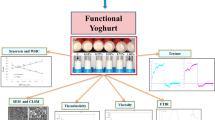Abstract
Carrageenan can be used as an encapsulation material due to its gelling properties. Sodium alginate is traditionally used encapsulation material. However, different structural and viability issues were observed in different studies. The aim of this study was to improve the survival of L. brevis LBR1 using alginate-carrageenan beads through structural optimization. L. brevis LBR1 was microencapsulated by extrusion technique using varying concentration of carrageenan and alginate (To (0%: 0%) T1 (0.01%:1.5%), T2 (0.02%:1.5%), T3 (0.03%:1.5%), T4 (0.04%:1.5%), T5 (0.05%:1.5%). The beads were evaluated for release profile, storage stability and survival under simulated gastrointestinal conditions. All the treatments showed better encapsulation efficiency. The addition of carrageenan improved the structure of sodium alginate beads with better interlinkage. The free cells could not maintain their viability in GIT conditions as compare to encapsulated cells. The T5 comparatively showed better stability in simulated intestinal conditions. However, slow release was observed as compare to other formulations. Encapsulation significantly improved the probiotic viability using different combinations of carrageenan and alginate.
Graphical abstract






Similar content being viewed by others
Change history
29 March 2022
A Correction to this paper has been published: https://doi.org/10.1007/s11694-022-01383-5
References
S.B. Begum, R.R. Roobia, M. Karthikeyan, R.M. Murugappan, LWT 60, 743–750 (2015). https://doi.org/10.1016/j.lwt.2014.10.024
A. Abruzzo, B. Vitali, F. Lombardi, L. Guerrini, B. Cinque, C. Parolin, F. Bigucci, T. Cerchiara, C. Arbizzani, M.C. Gallucci, B. Luppi, Pharmaceutics 12, 241 (2020). https://doi.org/10.3390/pharmaceutics12030241
S. Thangrongthong, N. Puttarat, B. Ladda, T. Itthisoponkul, W. Pinket, K. Kasemwong, M. Taweechotipatr, Food Sci. Biotechnol. 29(11), 1475–1482 (2020). https://doi.org/10.1007/s10068-020-00812-9
M. Afzaal, F. Saeed, M. Saeed, M. Azam, S. Hussain, A.A. Mohamed, M.S. Alamri, F.M. Anjum, Int. J. Food Prop. 23, 1899–1912 (2020). https://doi.org/10.1080/10942912.2020.1826513
M. Azam, M. Saeed, I. Yasmin, M. Afzaal, S. Ahmed, W.A. Khan, M.W. Iqbal, H.T. Hussain, M. Asif, J. Food Meas. Charact. (2021). https://doi.org/10.1007/s11694-021-00839-4
E. Valero-Cases, M.J. Frutos, LWT 64, 824–828 (2015). https://doi.org/10.1016/j.lwt.2015.06.049
A.T. Holkem, G.C. Raddatz, G.L. Nunes, A.J. Cichoski, E. Jacob-Lopes, C.R.F. Grosso, C.R. Menezes, LWT 71, 302–308 (2016). https://doi.org/10.1016/j.lwt.2016.04.012
T. Riaz, M.W. Iqbal, M. Saeed, I. Yasmin, H.A.M. Hassanin, S. Mahmood, A. Rehman, J. Microencapsul. 36, 192–203 (2019). https://doi.org/10.1080/02652048.2019.1618403
M.P. Silva, F.L. Tulini, M.M. Ribas, M. Penning, C.S. Fávaro-Trindade, D. Poncelet, Food Res. Int. 89, 582–590 (2016). https://doi.org/10.1016/j.foodres.2016.09.008
T. Ahmad, M. Cawood, Q. Iqbal, A. Arino, A. Batool, R.M.S. Tariq, M. Azam, S. Akhtar, Foods 8, 1–22 (2019). https://doi.org/10.3390/FOODS8090424
M. Afzaal, F. Saeed, M.U. Arshad, M.T. Nadeem, M. Saeed, T. Tufail, Probiotics Antimicrob. Proteins 11, 1348–1354 (2019). https://doi.org/10.1007/s12602-018-9485-9
I. Yasmin, M. Saeed, I. Pasha, M.A. Zia, Probiotics Antimicrob. Proteins (2018). https://doi.org/10.1007/s12602-018-9407-x
M. Azam, M. Saeed, I. Pasha, M. Shahid, Food Biosci. 37, 100679 (2020). https://doi.org/10.1016/j.fbio.2020.100679
W.A. Khan, M.S. Butt, I. Pasha, M. Saeed, I. Yasmin, M. Ali, M. Azam, M.S. Khan, J. Text. Stud. (2020). https://doi.org/10.1111/jtxs.12555
D.C. Montgomery, Design and Analysis of Experiments (Wiley, New York, 2017)
A. Atia, A. Gomaa, I. Fliss, E. Beyssac, G. Garrait, M. Subirade, J. Microencapsul. 33(1), 89–101 (2016). https://doi.org/10.3109/02652048
Y. Wu, G. Zhang, LWT- Food Sci. Technol. 93, 135–141 (2018)
L. Shi, Z. Li, Z. Zhang, T. Zhang, W. Yu, M. Zhou, Z.X. Tang, LWT-Food Sci. Technol. 54, 147–151 (2013)
Acknowledgements
The authors are thankful to the National Institute of Food Science and Technology, University of Agriculture, Faisalabad for providing technical support and laboratory facilities during research work.
Author information
Authors and Affiliations
Corresponding author
Ethics declarations
Conflict of interest
The authors declare that they have no conflict of interest.
Ethical approval
This article does not contain any studies with human participants or animals performed by any of the authors. Informed Consent For this type of study, formal consent is not required.
Additional information
Publisher's Note
Springer Nature remains neutral with regard to jurisdictional claims in published maps and institutional affiliations.
Supplementary Information
Below is the link to the electronic supplementary material.
Rights and permissions
About this article
Cite this article
Azam, M., Saeed, M., Ahmad, T. et al. Characterization of biopolymeric encapsulation system for improved survival of Lactobacillus brevis. Food Measure 16, 2292–2299 (2022). https://doi.org/10.1007/s11694-022-01334-0
Received:
Accepted:
Published:
Issue Date:
DOI: https://doi.org/10.1007/s11694-022-01334-0




